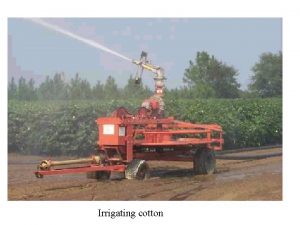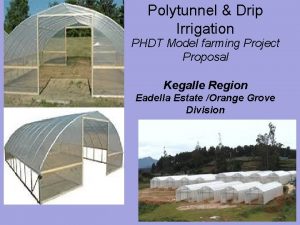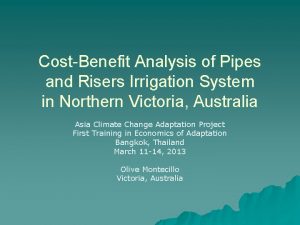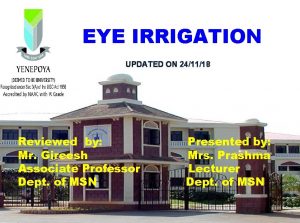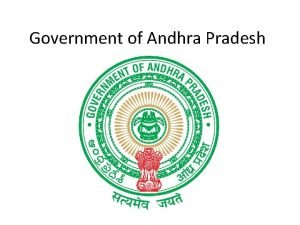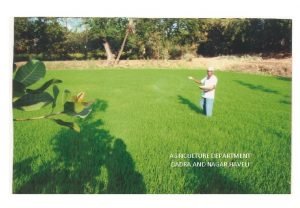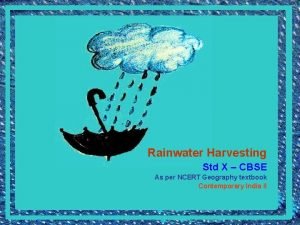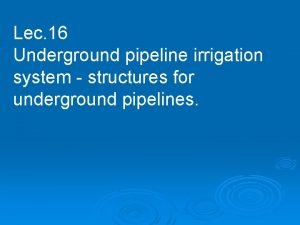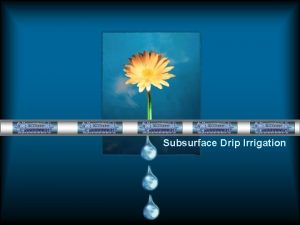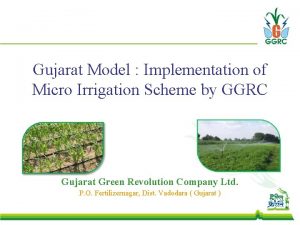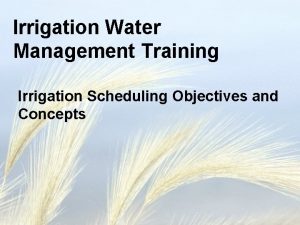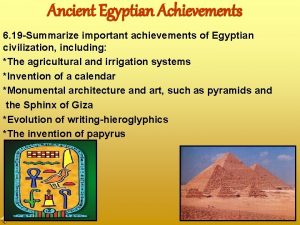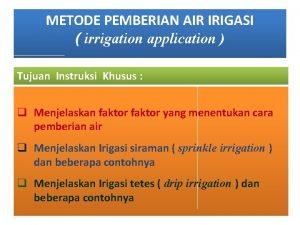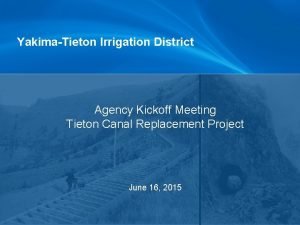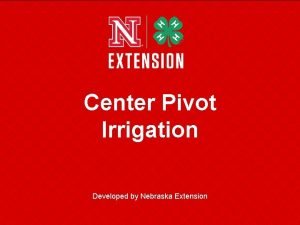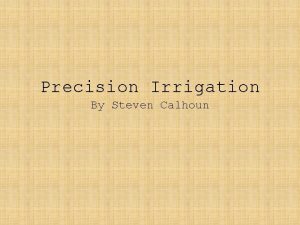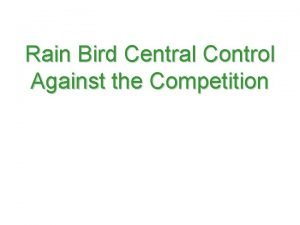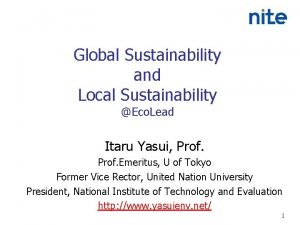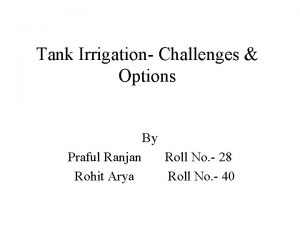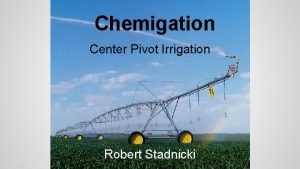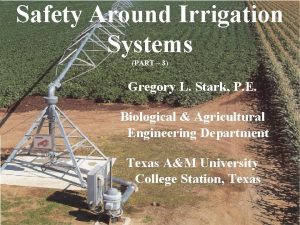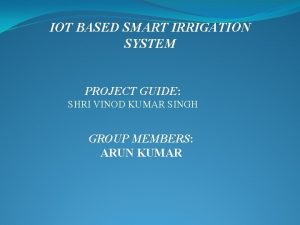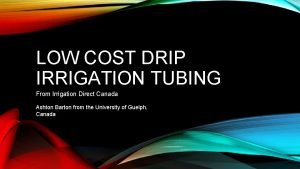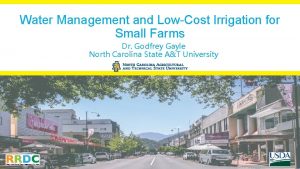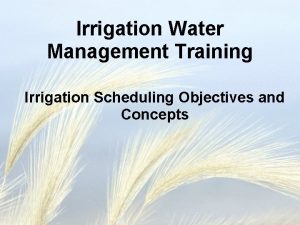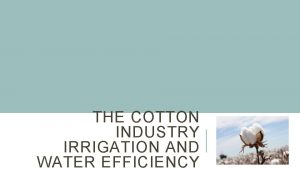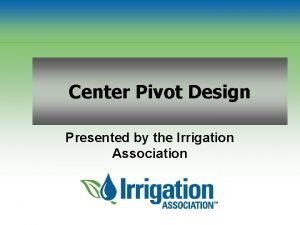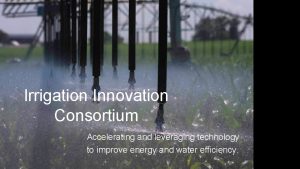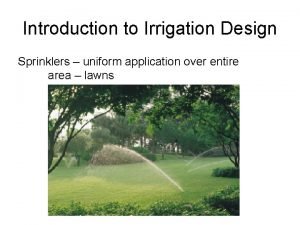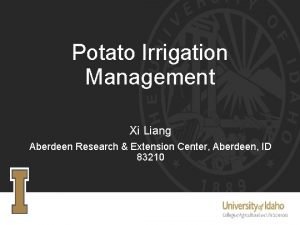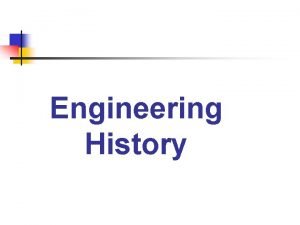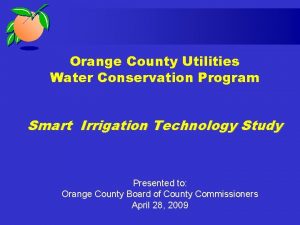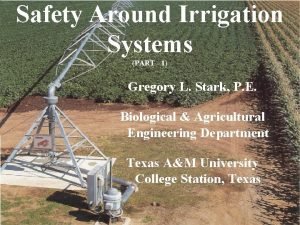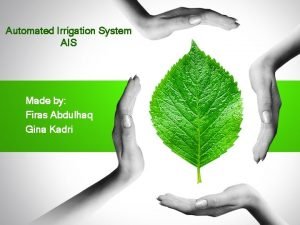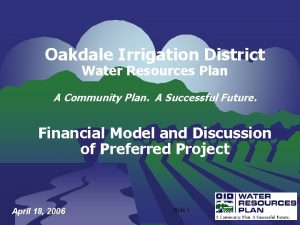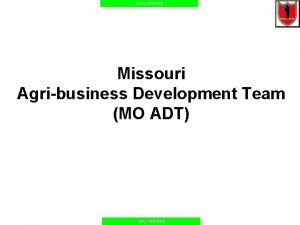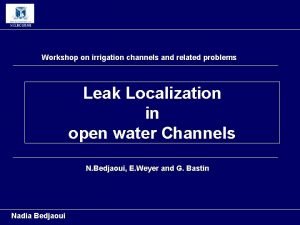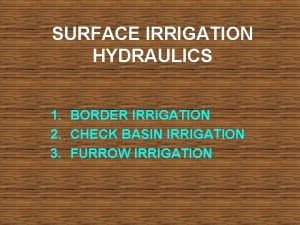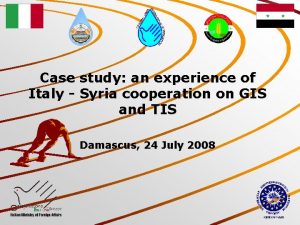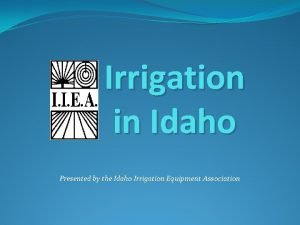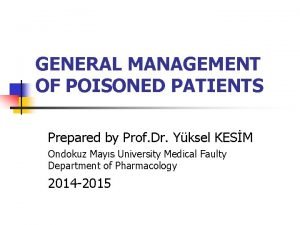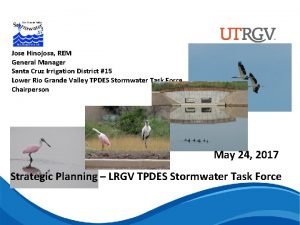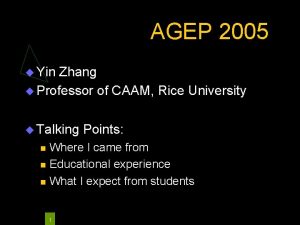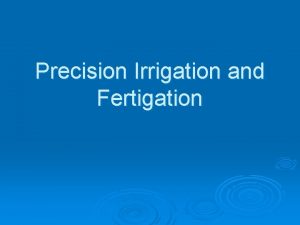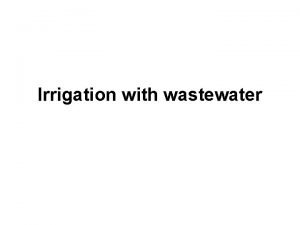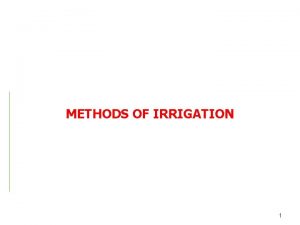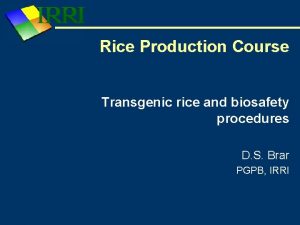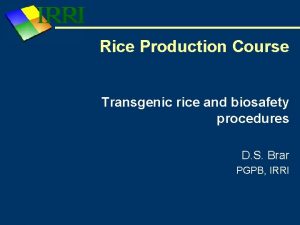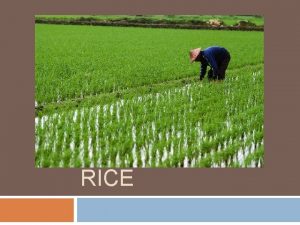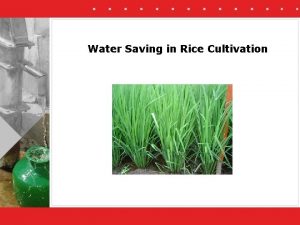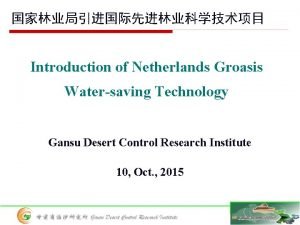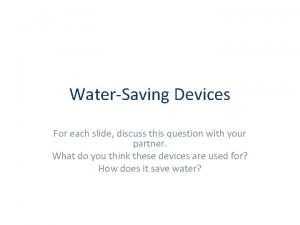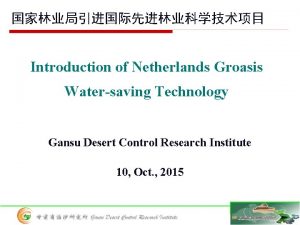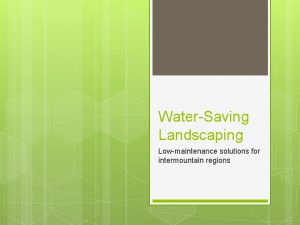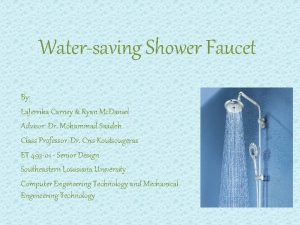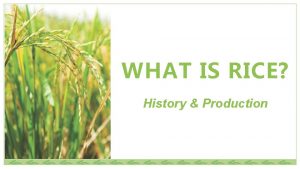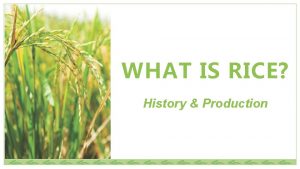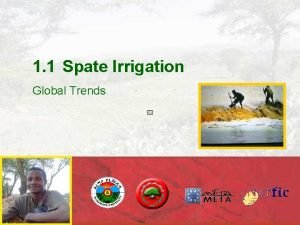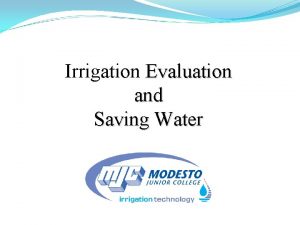Rice Production Course WaterSaving Irrigation in Rice R


































































- Slides: 66

Rice Production Course Water-Saving Irrigation in Rice R. Lampayan CSWS, IRRI

Content • Introduction: the water crisis • Water-saving technologies • Practical experiences • Sustainability issues • Conclusions IRRI: Rice Production Course

Rice grows under lowland conditions: puddled soil, permanently flooded IRRI: Rice Production Course

Rice and water • 75% of rice is irrigated (75 m ha) • Rice requires much water: 3000 -5000 l kg-1 rice • Irrigated areas consume 80% of all fresh water used; Asia: > 50% of this is for rice IRRI: Rice Production Course

Pressure to produce more food (rice) is getting greater because of ever increasing population But also: More people want • more industry • more drinking water • more cities • more swimming pools • more…. => Water is getting scarce and expensive IRRI: Rice Production Course

Is this the future for rice production……. ? IRRI: Rice Production Course

Competition, some examples in rice areas…. Beijing: 2001: ban on flooded rice ZIS (160, 000 ha)-city, industry ZIS: Ganges river: India-Bangladesh Cauvery river: Karnataka-Tamil Nadu IRRI: Rice Production Course

Reduced river flows IRRI: Rice Production Course

Tubewells and pumps for irrigation 70 60 50 40 India China 30 20 10 0 1966 1995 India (2000): 5 -6 million irrigation tubewells N China (2001): 3 -4 million irrigation tubewells IRRI: Rice Production Course

Groundwater depletion 1 -1. 5 m/y 0. 7 m/y Arsenic! IRRI: Rice Production Course

Conclusion Need to grow rice using less water in water-scarce or water-costly areas • Produce enough rice for growing population • Decrease cost of rice production • Save ‘little’ water in rice => free-up ‘much’ water for irrigation elsewhere and for use by other sectors (industry, cities, other crops) IRRI: Rice Production Course

To mitigate the looming water crisis, we need to “Produce more rice with less water” IRRI: Rice Production Course

Field water balance lowland rice IRRI: Rice Production Course

Water requirements in lowland rice Total season Typical value : 675 -4450 mm : 1500 mm IRRI: Rice Production Course

Water-saving measures • • • Good puddling Good bund maintenance Land leveling Crack plowing Short land preparation phase Communal seed beds Efficient use of rainfall (cropping calendar) Direct wet seeding …… IRRI: Rice Production Course

Water-saving irrigation technologies: Reduce seepage, percolation and evaporation • Saturated soil culture • Alternate wetting and drying • Aerobic rice IRRI: Rice Production Course

Field water depths in alternate wetting IRRI: Rice Production Course

Continuously flooded Alternate wetting and drying Yield (t/ha) IRRI: Rice Production Course

Continuously flooded Alternate wetting and drying Irrigation water (mm) Note: heavy clay soil with shallow groundwater (0 -30 cm deep) IRRI: Rice Production Course

Guimba 88 -90 (Tabbal et al. , 2002) Silty clay loam, groundwater 70 -200 cm Yield (t/ha) IRRI: Rice Production Course Total water (mm)

A fundamental approach to reducing water requirements in rice? Treat rice like any other (irrigated) crop: No puddling, no standing water, aerobic soil IRRI: Rice Production Course

Upland rice Breeding: Aerobic soil Drought tolerant Weed competitive Adverse soil conditions Low inputs (!) => Stable but low yields Unfavorable uplands IRRI: Rice Production Course

Different idea of rice like upland crop Breeding: from upland rice… Aerobic soil Input responsive Lodging resistant Weed competitive => Stable and high yields Lowland HYV traits Water-short irrigated areas ‘Favorable’ uplands IRRI: Rice Production Course

Improved upland… Dryland Rice… Han Dao… Aerobic Rice… IRRI: Rice Production Course

New Aerobic Rice Girls… IRRI: Rice Production Course

Early evidence: Brazil • Active program to develop upland rice varieties and management techniques since the 80’s => High-yielding aerobic varieties: 5 -7 t ha-1 with high inputs • State of Mato Grosso: 250, 000 ha commercial production (sprinkler irrigated) IRRI: Rice Production Course

Aerobic rice, Mato Grosso, Brasil Guimarães and Stone, 2000 IRRI: Rice Production Course

Early evidence: North China • Program to improve upland rice => Aerobic rice varieties with yield potential of 6 -7 t ha-1 Adoption on estimated 190, 000 ha (2001) in • Rainfed areas where rainfall is insufficient to sustain lowland rice production • Irrigated areas where water is scarce/expensive • Salt-affected areas • Flood-prone areas Q: What is water use, how to manage the crop? IRRI: Rice Production Course

IRRI: Rice Production Course

Hydrology field experiment Beijing, 2001: Explore aerobic rice yield and irrigation water use IRRI: Rice Production Course

IRRI: Rice Production Course

IRRI: Rice Production Course

Total water input (mm) Water treatment (Rainfall) IRRI: Rice Production Course

9 Yield (t/ha) 8 7 6 5 Lowland Aerobic 1 Aerobic 2 4 3 2 1 0 1394 644 577 586 519 469 Flooded -------- Aerobic ---------IRRI: Rice Production Course Water (mm)

IRRI, Philippines: 3 -4 varieties each season one flooded and one aerobic treatment IRRI: Rice Production Course

IRRI, 2001 DS: yield (t ha-1) in K 6/7 Fertilizer: 180 -60 -40 kg ha-1 NPK Pests and diseases: mole crickets (aerobic), stem borer, sheath blight; lodging in B 6144 F IRRI: Rice Production Course

IRRI, 2002 DS: yield (t ha-1) in K 6/7 Fertilizer: 120 -60 -40 kg ha-1 NPK IRRI: Rice Production Course

Water input, including land preparation (mm) Flooded Aerobic Lining of bunds Irrigation Rainfall IRRI: Rice Production Course

Practical experiences IRRI: Rice Production Course

Case study Tarlac & Nueva Ecija: Introducing alternate wetting and drying to farmers using shallow or deep wells for irrigation IRRI: Rice Production Course

Monitoring inputs: Irrigation water, seeds, fertilizer, pesticides, labor use, etc. And outputs: Grain yield and quality IRRI: Rice Production Course

Irrigation water used (mm) IRRI: Rice Production Course

Grain yield (t/ha) IRRI: Rice Production Course

Comparison between farmers’ practice and alternate wetting and drying (dry season 2001) Farmers’ practice Alternate wetting and drying Difference Total water used* (mm) 500 310 190 Pump O&M cost ($ ha-1) 112 69 43 Yield (t ha-1) 5. 7 5. 5 0. 2 Particulars * From transplanting up to harvesting IRRI: Rice Production Course

Partial budget comparison ($ ha-1) Farmers’ practice Alternate wetting and drying Savings Gross benefits 944 911 -33 Variable irrigation cost 148 96 52 ‘Net’ benefits 796 815 19 Particulars Comments irrigation manager and farmer community: can irrigate 30% more area with same amount of water !! IRRI: Rice Production Course

Case study Tarlac and Nueva Ecija, Philippines: Aerobic Rice Crop establishment (traditional technologies) IRRI: Rice Production Course

Farmer-participatory development; central Luzon. 2003: develop also modern technologies Laser-guided land leveling Automated seeder with basal fertilizer application Labor saving Efficient fertilizer use IRRI: Rice Production Course

Flush irrigation of the field only! IRRI: Rice Production Course

Weed control: traditional technology (plough, lithao, sagad) IRRI: Rice Production Course

IRRI: Rice Production Course

Results aerobic rice WS 2002; Canarem, Tarlac IRRI: Rice Production Course

Varieties: • Apo • UPLRI 5 • Magat (Hybrid) IRRI: Rice Production Course

Grain yield (T/ha) Yield range: APO (HT) (LT) Yield range: APO : 4. 1 - 5. 9 t/ha UPLRI-5 : 4. 0 - 5. 6 t/ha Magat : 4. 5 - 5. 4 t/ha : 2. 0 – 6. 6 t/ha : 2. 0 – 6. 0 t/ha UPLRI-5 (HT) : 3. 3 – 5. 3 t/ha (LT) : 2. 2 - 5. 3 t/ha IRRI: Rice Production Course

Sustainability issues with increased aerobic conditions IRRI: Rice Production Course

Aerobic rice, Mato Grosso, Brasil Guimarães and Stone, 2000 Rice production system Rice after 3 years soybeans Rice after 1 years soybeans Rice monocrop (5 years) Yield (kg ha-1) 4, 325 2, 577 1, 160 Fertilization 300 kg of 4 -30 -16 N, P, K at planting; 150 kg ammonia sulfate 50 Course DAS IRRI: Riceat Production

Field experiments at Dapdap (dry season) • Irrigation experiment (4 treatments) • Nitrogen experiment (5 treatments) Mixed upland-lowland area with sandy-loam soil IRRI: Rice Production Course

No more crop growth after tillering…. IRRI: Rice Production Course

Roots affected by nematodes Healthy Field experiment IRRI: Rice Production Course

Irrigation experiment Varieties: V 1 = Apo V 2 = Magat V 3 = PSB Rc 98 Irrigation: W 1=2/week W 2=1/week W 3=1/2 week W 3=variable IRRI: Rice Production Course

Nitrogen experiment Varieties: V 1 = Apo V 2 = Magat V 3 = PSB Rc 98 Nitrogen: N 1 = 0 kg N 2 = 100 kg N 3 = 140 kg N 4 = 180 kg N 5 = 220 kg IRRI: Rice Production Course

Nematode count at harvest; nitrogen experiment IRRI: Rice Production Course kg N ha-1

Nematode count from lowland rice farmers IRRI: Rice Production Course

Nematode count/g fresh root (Meloidogyne graminicola) 2000 2001 2002 2003 Wet season Dry season AA 6 875 491 2530 1499 2089 AF 9 279 11 1760 27 3054 FF 2 6 4 134 34 380 Sampled from roots at harvest Aerobic Flooded IRRI: Rice Production Course Wet season

Conclusions for Controlled Irrigation ü An average water savings of about 20% was attained in both deepwell and shallow tubewell systems. ü Forty percent (40%) of water savings has also been attained in some fields. ü No significant yield difference has been observed between CI and FP plots. ü Farmers achieved an average increased net profit of about $20 per ha in deepwell and shallow tubewell systems. IRRI: Rice Production Course

Conclusions tropical aerobic rice Where are we after 2 years in the program? 1. Identified varieties with yield potential of 6 t ha-1, using about half the water used in lowland rice (Apo, Magat, UPLRI 5, and more) 2. Rough management recommendations that can deliver 3. about 4. 5 t ha-1 of the yield potential 3. Established a successful partnership to fully develop the aerobic rice technology (IRRI, NIA, Phil. Rice and farmers) 4. Under water scarcity: extremely urgent to develop sustainable crop rotations (nematodes!) 5. We stand at a successful beginning IRRI: Rice Production Course

AWD, aerobic rice “Target domain” Yield Diversification (nonrice crops) AWD Crack plowing Compaction Good puddling ……. . Flooded lowland Aerobic rice Upland Low High Water availability IRRI: Rice Production Course
 Memasarkan produk multimedia termasuk dalam proses produksi
Memasarkan produk multimedia termasuk dalam proses produksi Course interne course externe
Course interne course externe Half brick wall in stretcher bond
Half brick wall in stretcher bond Course title and course number
Course title and course number Tow line irrigation
Tow line irrigation Polytunnel farming
Polytunnel farming Pipe and riser irrigation systems
Pipe and riser irrigation systems Chestermere lake irrigation
Chestermere lake irrigation What is the purpose of eye irrigation
What is the purpose of eye irrigation Irrigation database
Irrigation database Ap cm dashboard
Ap cm dashboard Crops grown in dadra and nagar haveli
Crops grown in dadra and nagar haveli Bamboo drip irrigation system in meghalaya
Bamboo drip irrigation system in meghalaya Underground pipeline for irrigation
Underground pipeline for irrigation Sdirow
Sdirow Egyptian irrigation systems
Egyptian irrigation systems Mis tracking ggrc
Mis tracking ggrc Holman spray gun
Holman spray gun Flannery irrigation
Flannery irrigation Objectives of irrigation water management
Objectives of irrigation water management Gastroscopy indications and contraindications
Gastroscopy indications and contraindications Egyptian irrigation systems
Egyptian irrigation systems Bubbler irrigation
Bubbler irrigation Yakima tieton irrigation district
Yakima tieton irrigation district Center pivot sprinkler nozzles
Center pivot sprinkler nozzles Muslim irrigation and underground wells
Muslim irrigation and underground wells Eye irrigation introduction
Eye irrigation introduction Surface irrigation
Surface irrigation Rain bird central control
Rain bird central control Quantec-e irrigation system
Quantec-e irrigation system グアノ 枯渇
グアノ 枯渇 Tank irrigation definition
Tank irrigation definition Robert stripling
Robert stripling Irrigation system hazards
Irrigation system hazards Economic importance of sunflower
Economic importance of sunflower Smart irrigation system
Smart irrigation system Irrigation direct
Irrigation direct Surface irrigation
Surface irrigation Objectives of irrigation scheduling
Objectives of irrigation scheduling Lateral move irrigation advantages and disadvantages
Lateral move irrigation advantages and disadvantages Center pivot irrigation layout
Center pivot irrigation layout Irrigation innovation consortium
Irrigation innovation consortium Uniform irrigation
Uniform irrigation Sugarcane drip irrigation
Sugarcane drip irrigation Potato irrigation management
Potato irrigation management Egyptian irrigation systems
Egyptian irrigation systems Irrigation orange county
Irrigation orange county Irrigation system hazards
Irrigation system hazards Ais irrigation
Ais irrigation Oakdale water management
Oakdale water management Lateral move irrigation advantages and disadvantages
Lateral move irrigation advantages and disadvantages Itec irrigation controller
Itec irrigation controller What are the necessity of irrigation
What are the necessity of irrigation Adt irrigation
Adt irrigation Types of irrigation
Types of irrigation Check basin irrigation advantages and disadvantages
Check basin irrigation advantages and disadvantages Tis irrigation
Tis irrigation Idaho irrigation equipment association
Idaho irrigation equipment association Whole bowel irrigation
Whole bowel irrigation Santa cruz irrigation
Santa cruz irrigation Shall we let's go
Shall we let's go Caam rice
Caam rice Mechanical clock 700s
Mechanical clock 700s Http://teachertech.rice.edu/participants/louviere/newton/
Http://teachertech.rice.edu/participants/louviere/newton/ Cox
Cox Rice v paladin enterprises
Rice v paladin enterprises Teeth is countable or uncountable
Teeth is countable or uncountable




